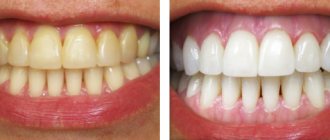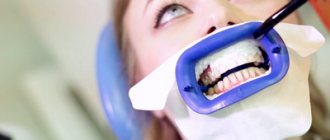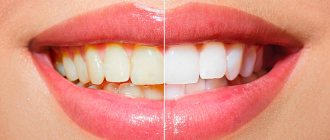Modern dentistry offers various methods to maintain healthy and crystal white teeth. But situations often arise when the only way to save a tooth is to remove the pulp. Although today it is very rare to use materials for canal filling that can change the shade of the enamel, after removal of the nerve, darkening of the tooth surface is observed over time due to its necrosis. Such modifications significantly spoil the smile and cause aesthetic discomfort.
Dentists at the Berezka clinic whiten a dead tooth and after the procedure it is completely no different from other units of the dentition.
Why does a dead tooth turn dark?
Teeth that lack nerves inside are considered dead. The surface of such processes is characterized by a tendency to change color and the appearance of dark spots. The reasons for the darkening of a pulpless tooth are as follows:
- lack of food. After the nerve is removed, the power to the tooth stops. Moisture leaves the enamel, nutrients are not supplied by the nerve endings, which leads to darkening;
- increased vulnerability. Without regular feeding, the tooth becomes very vulnerable. Pores form on the surface of the enamel, through which various coloring substances from the food consumed penetrate into the internal tissues. These dyes change the color of the enamel.
These are the most common reasons why tooth enamel darkens. In such cases, superficial bleaching of the dead tooth will help restore whiteness. But there are also often cases where a tooth has lost its original color due to bleeding during pulp removal. As a result, the enamel becomes reddish or purple. Classic whitening will not provide results in such situations; a more complex procedure will be required.
Causes of darkening of enamel
The shade of enamel is influenced by many different factors; most often it darkens due to the following reasons:
- Poor oral hygiene and plaque accumulation
- Smoking
- Abuse of tea, coffee and other drinks with coloring substances
- Rinsing the mouth with solutions containing chlorhexidine
- Use of iron supplements in liquid form
- Caries
- Demineralization, erosion and other enamel defects
- Treatment with antibiotics from the tetracycline group
- Tooth removal
- Fluorosis
- Dental injuries
- Age-related darkening of enamel
- Genetically determined dark shade of enamel
Typically, tooth discoloration is caused by a combination of several factors, so an integrated approach is important when it comes to whitening.
Features of whitening at home
Home whitening of a dead tooth is a very convenient method, but in this case it very rarely provides the required effectiveness. This is explained by the fact that at home, as a rule, products are used that only have an external effect. Sometimes such methods are not enough to lighten the enamel and without introducing special components into the tooth cavity it is simply impossible to return it to its natural shade.
At home, whitening gels are usually used, which, after penetrating the enamel, activate chemical reactions in it. It is necessary to work with such substances with extreme caution, since there is a high risk of not only damaging the enamel structure, but also damaging the mucous membranes. Therefore, it is best to trust such procedures to specialists who can prevent possible risks.
Is it possible to whiten a filling on a front tooth?
Most people, when filling the front teeth, over time wonder whether it is possible to whiten teeth with fillings and what is the result? – it is possible to lighten the enamel and filling, but only under certain conditions and in the absence of contraindications. First, the patient needs to go to the dentist for a full examination of the oral cavity.
When whitening teeth with fillings on front teeth with a small filling area, the old layer is first removed and a new one with the required shade is applied. You can do it differently, first perform a complete lightening, and only then install a new filling, taking into account the tone of the teeth.
Call us or 8 (926) 100-10-10
Professional whitening of pulpless teeth
Whitening a dead tooth in a dental office is a completely safe and most effective procedure. One of the popular methods of professional lightening is endobleaching. The procedure is carried out in the following order:
- First, the dentist removes the old filling from the pulped tooth;
- then a special bleaching agent is introduced into its internal cavity. In most cases this is sodium perbonate, if necessary a small amount of hydrogen peroxide is added to it;
- After this, the doctor installs a temporary filling. If it is necessary to re-inject the brightening reagent, the filling is removed again. The number of procedures depends on the degree of darkening of the tooth;
- Once the desired color is achieved, a permanent filling is placed on the tooth.
In addition to intracanal bleaching, the dentist may also suggest other methods, for example, the use of veneers or crowns.
How to paint metal ceramics
One of the options for lightening fillings and crowns is to stain them. For this purpose, various compositions are used today: liquid enamel, professional dental paints and varnishes. Recently, Dental Paint has gained particular popularity. One of its main advantages is that it allows you to paint even hard-to-reach places, and also successfully solves the problem of darkening of filling materials, crowns and dentures. With its help, you can achieve lightening of up to 10 tones, and at the same time the result will look natural1.
Dental Paint can be used to lighten teeth
However, this method also has one significant drawback - the effect will be short-lived, so the procedure will soon have to be repeated. This method is similar to applying makeup, because the paint will be washed off after the first brushing of your teeth. Yes, and you cannot use such products on an ongoing basis, since this can lead to the destruction of the filling or crown. The materials from which they are made do not absorb paint, so it is impossible to change their color in this way. In such cases, dental experts recommend timely replacement of restorative materials and prostheses.
Contraindications
It is necessary to refuse the intracanal bleaching procedure in the following cases:
- with increased tooth sensitivity;
- for dental diseases and inflammatory processes of the oral cavity;
- if the patient has caries or periodontitis;
- women during lactation should refrain from the procedure;
- Whitening is contraindicated for children and adolescents under 16 years of age.
Any of these factors can lead to undesirable consequences, so if at least one of them is present, you should think about the advisability of whitening and weigh all the possible risks.
Which teeth should not be whitened?
Whitening is not carried out if there is untreated caries in the oral cavity, exposed tooth necks, or enamel damage. If there are composite fillings, the procedure will give an uneven effect, because the color of inorganic materials is not subject to change. The most correct thing would be to install a temporary filling and carry out whitening before the final restoration of the tooth.
The procedure is also not carried out in the presence of braces due to the unguaranteed and uneven result. Exposure to chemicals on the enamel of hypersensitive teeth is undesirable.
Whitening prognosis and complications
Whitening a dead tooth is a fairly serious procedure that involves chemical action on tooth enamel. Therefore, before carrying out it, you should familiarize yourself with possible complications:
- the fragility of the result obtained, which necessitates repeated bleaching;
- The enamel of a dead tooth does not always acquire the same shade as healthy teeth. Even after lightening, the enamel can stand out from the rest;
- the enamel coating of a pulpless tooth after bleaching becomes even more fragile, in some patients it even begins to crumble and collapse;
- When applying the whitening component, the gums are irritated, so it should be done with extreme caution in patients prone to gingivitis, periodontitis and other pathologies.
Only a specialist can accurately determine whether intracanal bleaching is worthwhile or whether to look for safer alternative methods.
The Berezka dental clinic employs highly qualified specialists who can be trusted with complete confidence in tasks of any complexity and without worrying about unpleasant consequences.
Ultrasonic cleaning and its effectiveness
You can restore the natural whiteness of your smile and lighten artificial crowns a little using the procedure of Prof. hygiene. The method involves cleaning teeth from plaque and deposits, and today various technologies are used for this purpose, including an ultrasonic scaler. This is a hardware technique that involves delivering ultrasonic waves and microvibrations through a special tip, which literally break hardened deposits into tiny particles. At the same time, a jet of water is supplied, which removes dirt and also protects the enamel surface from overheating.
As part of comprehensive hygiene, ultrasonic or laser cleaning is usually combined with sandblasting of enamel using an Air-Flow device. This is a mandatory preventive procedure that should be performed every six months. But here it is worth noting that it will not help whiten either fillings or crowns. Lightening occurs only by removing plaque and deposits.
The photo shows the method of brushing teeth with the Air Flow system.
Type and size matters
The answer to the question whether it is possible to whiten filled teeth largely depends on the type of material:
- cement - the cheapest and very fragile type;
- photopolymer - high-quality material, contains phosphorus;
- metal – used to restore chewing teeth;
- glass ionomer cement – used to prevent caries.
Each type has the ability to whiten, but low-quality material does not lighten as well, so dentists do not recommend using it.
The procedure does not give a permanent result; the enamel remains white for a long time, but there is no filling; after a while the manipulation will have to be repeated.
Whether fillings are whitened during regular teeth whitening also depends on the size of the filled area. Small areas are easily bleached; after a while, such fillings can be covered on top with a new, beautiful layer (the main thing is to accurately select the original shade) or the material can be completely replaced. It's not very expensive and doesn't last long.
With large areas it is more difficult. After a whitening session, the filling areas become stained, and the same problem occurs with the front teeth.
In this case, it is better to use ceramic or.
How to deal with depulpation
Depulpation is the removal of the nerve from the dental body.
When the pulp and nerve are removed, the tooth dies and eventually turns black inside. Pulpless teeth are yellowish. In this case, regular lightening will not bring results.
Intracanal manipulation has been developed for pulpless teeth. The essence is this: the root canal is filled, then a gel solution is injected, which brightens the dark places, and a crown is applied on top. The patient chooses the color of the crown himself.
Why is it better to do whitening after filling, but before prosthetics?
If you want to undergo a whitening procedure, but also have a filling, you still need to take care of your dental health first. For example, professional in-office whitening is carried out only after removing plaque and deposits, installing fillings or replacing them. You should immediately discuss your plans with your doctor and select the material of the desired shade.
As for prosthetics with crowns, this procedure can be carried out after bleaching. This will make it easier to choose a ceramic shade that exactly matches the current enamel color.
Principles of caring for metal-ceramic crowns
To prevent darkening of fillings and crowns, it is important to provide competent and systematic oral care. As mentioned above, basic hygiene rules include regular brushing of teeth twice in the morning and evening, rinsing after each meal, as well as visiting the dentist for prevention and cleaning of dental plaque at least once every six months.
If you have a bridge in your mouth with metal-ceramic crowns, it is important not to forget to clean the rinsing channel located between the gum and the structure. An irrigator is ideal for these purposes. Experts in the field of prosthetics also provide the following recommendations regarding the care of metal ceramics:
- try to avoid temperature changes in food and drinks, due to which the porosity of the material increases and it turns yellow,
- If possible, avoid coffee and strong black tea, since these drinks quickly lead to staining,
- You should not gnaw hard foods with your teeth or crack the shells of nuts and seeds.
An irrigator is an additional device for maintaining oral hygiene.
To keep your teeth healthy and your smile snow-white, you need to pay enough attention to caring for and maintaining hygiene. Modern fillings are made from high-quality materials that cannot be stained for a long time. The same can be said about modern dental ceramics, which are distinguished by their durability, high aesthetics and color fastness. Therefore, with proper care, the material will not darken and will retain its aesthetic properties throughout its entire service life.
1According to data at the office. manufacturer's website: dentalpaint.ru.
The power of a smile
Facts about laughter
- 10-15 minutes of laughter burns the equivalent of a 100g chocolate bar.
- 100 km/h - this is the speed at which air escapes from the lungs when laughing.
- 17 minutes of laughter a day prolongs life by one year.
- Cheerful people are 40% less likely to suffer from heart disease.
- A person uses 17 facial muscles to smile, and 43 to frown.
- The most smiling people live in Brazil and Cuba.
- 69% of men consider women with an open smile attractive, preferably without makeup.
Laughter is the best medicine. Do you think this is just a figurative expression? Not at all. This is a proven fact! Laughter relieves stress and lifts your spirits, and recent research has shown that it can even fight disease.
While all social gestures of acceptance - handshakes, hugs, head nods - have multiple interpretations depending on cultural traditions in different countries, smiling is a universal sign of happiness, interpreted positively in all languages of the world. A snow-white smile is a sign of not only happy people, but also successful people.











